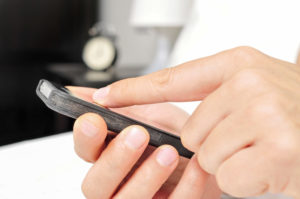 This week I’m blogging about an M-word. Not MACRA or MIPS, but Mobile Health or mHealth. A warning before you proceed: The following paragraph contains a personal story that may be Too Much Information (TMI).
This week I’m blogging about an M-word. Not MACRA or MIPS, but Mobile Health or mHealth. A warning before you proceed: The following paragraph contains a personal story that may be Too Much Information (TMI).
Last week I woke up at 2 am on Wednesday morning with a stomach virus. My husband, Frank, woke up at 3 am similarly afflicted. We had a long night. At 7 am, without much more effort than raising my head, I picked up my smartphone from the bedside table and began to rearrange my day. I used my calendar app to check the day’s schedule. I sent text messages to some folks and emails to others to tell everyone I wouldn’t make it into the office. I cancelled some meetings and rescheduled others using my iPhone, and Frank did the same using his iPad. Neither of us had to crawl out of bed to collect a laptop. We were able to use small mobile devices that are so handy and pervasive we’d left them on the bedside table the night before.
This event reminded me how much my mobile device supports my daily life. I have 68 apps on my iPhone for whole range of activities, including email, text messaging, and FaceTime. Some apps make life fun like my camera and photo apps and others make life convenient like the Open Table app I use to make dinner reservations without a single phone call. Six of my apps are health related, including my new Fitbit app, the UptoDate app, and the CVS pharmacy app. The CVS pharmacy app allows me to refill a prescription and then swing by the drive-through window to collect and pay, simply by showing a bar code on my phone.
How big is the mHealth industry?
Greatcall, a company that provides remote home support services for patients and caregivers, recently published an infographic on mHealth with some interesting data:
- In 2017 the practice of medicine using mobile devices will be a $26 billion industry
- Today there are more than 97,000 health and fitness apps available for download to mobile devices
- The top mHealth downloads are focused on weight loss, fitness, and sleep
- 80% of physicians use smart phones and medical apps
- 93% of physicians believe mHealth apps can improve patient health
- More than 25% of physicians are using mobile technology to provide patient care
Why is mHealth growing?
In the January 4 geekdoctor blog post, Dr. John Halamka, CIO of Beth Israel Deaconess Medical Center and Chairman of the New England Healthcare Exchange Network, wrote about 2017 health IT priorities. In his opinion, bringing mobile devices and associated apps into the center of patient care is a priority for several reasons. As in my case with my iPhone at the bedside, mobile devices are convenient and portable. In addition, the user experience for a mobile device that includes voice, touch, and gesture input is a better user experience than traditional keyboard data entry. Also, the growing number of mobile apps offer good services and have the benefit of back-end services like application programming interfaces (APIs) that make data sharing easy. He provides the example of a mobile device app that allows a patient picture to be uploaded into an EHR.
When I asked Eddie Hedrick, VP Information Technology Group at Fresenius, how mHealth has impacted health IT from a user experience standpoint, he noted that the pervasive presence of mobile devices creates opportunity for the consumer-driven model of data sharing. For example, new mobile apps allow patients to collect medication lists from multiple EHRs and aggregate them into a single master medication list that can be shared as the patient desires. This patient-initiated action simplifies sharing since there are no HIPAA roadblocks.
Eddie also cites the Acumen mobile app as a good example of mHealth flexibility for physicians. This application on a mobile device has an API that communicates over the internet with the “cloud” where data is stored. If you are doing dialysis rounds and request lab data on a patient, only the data you ask for is pulled down onto the mobile device when you need it. The “cloud” stores years of data for many patients, but the mobile app requests only what you need. The data is stored on your mobile device temporarily and part of the app intelligence is to know when the data cache can be erased, such as when you move to a different patient record or when the rounding session ends. Mobile app API connections to stored data sources like the “cloud” require internet connections to move data in real time, but apps usually allow offline data capture with delayed data exchange when internet access is available.
mHealth privacy and security
The future for mHealth looks rosy. Certainly it will be great to see all of the daily life conveniences of a smartphone drift into health care. But, with mobility comes new responsibility for privacy and security.
Eddie Hedrick notes that data transmission from a mobile device to a stored data source occurs over the internet in a way that’s similar to all web-based applications. The internet data transmission needs to be secure and any data stored permanently on the mobile device should be encrypted. Mobile devices are stand-alone data platforms; they aren’t designed to be kept behind a locked door like desktop computers, so they can’t be left sitting around unlocked with unencrypted PHI.
PHI on mobile devices must meet the same security standards as non-mobile devices, yet this mobile technology brings new risks including:
- Losing a device (it’s difficult to misplace a desktop computer, but easy to leave your iPad somewhere)
- Having a device stolen
- Downloading a virus or malware while using external networks
- Sharing a mobile device
- Using an unsecure network
Some mHealth security solutions are the same regardless of the form of your device. Technology devices in your organization should require strong passwords, use auto log-off, and require a unique user ID. New security considerations for mobile devices include:
- Using encryption
- Enabling a remote wipe of the data
- Making sure the device is lockable
- Keeping the device with you…. no sharing
- Using a secure network including a virtual private network (VPN) if in public
HealthIT.gov publishes good tools for risk assessment of your mHealth strategy, including the need to plan and do a risk analysis. This website offers videos covering privacy, security, and risk assessment to help you adopt mobile devices within your practice.
mHealth has the advantage of convenience and a good user experience. It offers benefits to patients in access to data that promotes patient engagement in care, which ultimately improves outcomes. New apps will not only track and consolidate data, but offer data insights to help patients and physicians. While mobile devices and apps may provide physicians with a better user experience for patient and population health care delivery, data security presents new issues. Don’t forget your responsibility for security and risk analysis for your mHealth devices.
 Dugan Maddux, MD, FACP, is the Vice President for CKD Initiatives for FMC-NA. Before her foray into the business side of medicine, Dr. Maddux spent 18 years practicing nephrology in Danville, Virginia. During this time, she and her husband, Dr. Frank Maddux, developed a nephrology-focused Electronic Health Record. She and Frank also developed Voice Expeditions, which features the Nephrology Oral History project, a collection of interviews of the early dialysis pioneers.
Dugan Maddux, MD, FACP, is the Vice President for CKD Initiatives for FMC-NA. Before her foray into the business side of medicine, Dr. Maddux spent 18 years practicing nephrology in Danville, Virginia. During this time, she and her husband, Dr. Frank Maddux, developed a nephrology-focused Electronic Health Record. She and Frank also developed Voice Expeditions, which features the Nephrology Oral History project, a collection of interviews of the early dialysis pioneers.
Image from www.canstockphoto.com



Leave a Reply